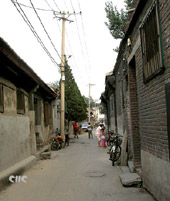How many hutongs are there in Beijing? Old local residents have a
saying: "There are 360 large hutongs and as many small hutongs as
there are hairs on an ox." Laid out in a chessboard pattern which
was established as early as the Ming Dynasty, these hutongs
crosscut the city into tiny squares. In those days the capital was
divided into the eastern, western, northern, southern and central
districts, with a total of 33 neighborhoods, divided again into
hutongs.
In the Tang Dynasty, the city, then named Youzhou, was divided
into 28 walled residential districts guarded by sentries. A curfew
was enforced at night. Youzhou was renamed Xijunfu in the Liao
Dynasty and the city was divided into 26 residential districts. In
the Jin Dynasty it became Zhongdu (the Central Capital) and was
divided again into 60 residential areas. Under the Yuan, the city
was renamed Dadu (Great
Capital) and divided into 50 districts, including Jintaifang
(Golden Terrace District) and Wendefang (Literature and Morality
District).
The 33 neighborhoods mentioned above were established under the
Ming emperors Hongwu (reigned 1368-1398) and Jianwen (reigned
1399-1402). The figure increased to 40 after the time of Emperor
Yongle (reigned1403-1424).
The Qing rulers made use of the existing city structure and
divided the capital into five districts, reducing the number of
residential districts to 10. During the last years of Dynasty, the
old residential district system was abolished and Beijing divided
into 10
outer districts and 12 inner districts. The city is now divided
into four districts -- East City, West City, Chongwen and Xuanwu --
each of these comprised of numerous sub districts.
At present, there are about 4,550 hutongs, the broadest over
four meters wide and the smallest -- the eastern part of Dongfu' an
Hutong, a mere 70 cm across -- just wide enough for a single person
to traverse. Although the city has changed a great deal over the
last 500 years, the hutongs remain much the same as during Ming and
Qing times.
 |
Beijing's best known hutongs are of three types: centers of
government offices, residential areas for nobles and officials, and
old markets. Lumicang (Salary Rice Granary) Hutongs, in the
neighborhood of today' s Nanxiao Street, is the site of the former
nine imperial granaries of the late Ming and early Qing. Each year,
large amounts of grain were brought in from Zhejing Province to the
capital and stored in Lumicang District. Hutongs in the area took
on the names of the various granaries, names that have stuck to
this day. Then there's Xishiku (Western General Warehouse) Alley
off Xi' anmennei Street, once called Houku Dajie (Back Warehouse
Street) for its 10 warehouses serving the imperial palaces and
gardens.
Dongchang (Eastern Prosperity) Hutong, originally called
Dongchang (eastern Yard) Hutong, located south of the National Art
Galley, was named in the Yongle period
for the offices of the newly created eunuch administration. The
Dongchang had a reputation for terrorizing innocent people. It was
here that the eunuchs Liu Jin and Wei Zhongxian had numerous
people, including members of the imperial family, high officials
and nobles, put to death.
The second group of hutongs is named after the officials or
nobles who resided there. When Emperor Yongle of the Ming Dynasty
established Beijing as the capital, most of his officials moved
from Nanjing. The alleys they lived in took on their names.
Yongkang Hutong in the north was originally named Marquis Yongkang
Lane after the Yongkang Marquis, Xu Zhong. Sanbulao
(ThreeNever-Old) Hutong on the West City District was originally
named Sanbao Laodie (Father Sanbao) Alley after the "Sanbao" court
eunuch, Zheng He, who lived there. Sanbao is a corruption of the
original name; Laodie is a term of respect for an elder person.
In the East City District is the Red Star Hutong, once named His
Excellency Wuliang (Immeasurable) Alley, taken from the name of
Emperor Hongwu's general Wu Liang (Written differently from
wuliang, immeasurable). In Xisi (Western Four Archways), there are
the Front, middle and Rear Maojiawan hutongs, said to have once
been home of the Ming Dynasty scholar Mao Wenjian.
Finally. There are those hutongs, which derive their names from
old markets and trading centers. These include Xianyukou (Fresh
Fish Market), Luomasi (Horse and Mule Market), Gangwasi (Pottery
Market), Yangsi (Goat Market), Meisi (Coal Market) and Zhubaosi
(Jewelry Market). Other hutongs are named for historical sites and
ancient relics. Qilinbei (Unicorn Stela) Hutong, north of Eastern
Di' anmen Street, is named for a Ming Dynasty stela that once stood
at its entrance.
Anecdotes and legends abound. There is a slab of stone, the
top(or "hat") of which is carved into a beautiful branch of plum
blossoms with a crescent moon at its tip in the Xianyougong
Illustrious Blessing Hall) in Mao' er (Hat) Alley. Story has it
that there was a "plum blossom girl"who painted such lovely
blossoms in the old days.?
(China.org.cn May 31, 2007)